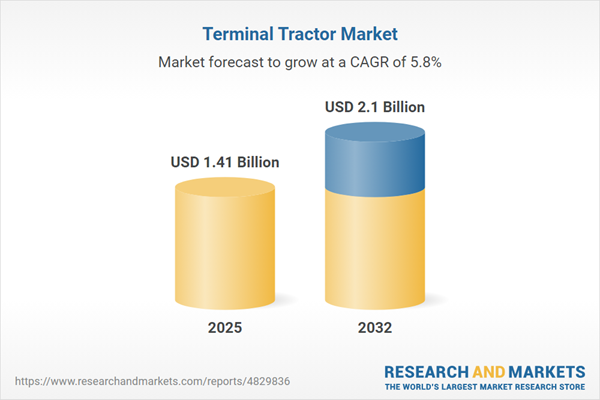Speak directly to the analyst to clarify any post sales queries you may have.
Terminal tractors are emerging as vital enablers in the logistics sector, enhancing operational reliability and supply chain efficiency for forward-looking organizations. As digital transformation reshapes logistics strategies, the terminal tractor market becomes a critical focus for senior decision-makers navigating evolving regulatory, technology, and competitive landscapes.
Market Snapshot: Terminal Tractor Market Size and Growth
The global terminal tractor market is witnessing steady expansion, supported by robust growth rates projected through the decade. Investments are accelerating, driven by advances in automated fleet management, rising adoption of low-emission powertrains, and widespread fleet modernization by logistics operators. Executives are increasing capital allocation to optimize fleet adaptability, integrate digital features, and align with evolving sustainability and regulatory mandates. This dynamic environment is fueling greater demand for technologically advanced terminal tractor solutions, positioning the sector at the center of logistics innovation.
Scope & Segmentation of the Terminal Tractor Market
This report delivers actionable insights to help senior leaders anticipate trends and prioritize opportunities across every area of the terminal tractor market. Understanding the following segments is fundamental for effective investment and resource planning:
- Powertrain: Includes diesel, electric (lead-acid and lithium-ion), hybrid, and LNG models, ensuring alignment with decarbonization strategies and diverse fueling needs.
- Horsepower Range: Spans options under 100 horsepower, between 101–150 horsepower, and above 150 horsepower, supporting both routine logistics and heavy-duty cycles.
- Operation Mode: Encompasses manual, automatic, and autonomous modes, utilizing advanced technologies such as lidar and machine vision for greater operational safety and precision.
- Speed Category: Covers vehicles operating below 20, between 20–25, and above 25 kilometers per hour, supporting deployment on sites with varied throughput requirements.
- Application Segment: Addresses key areas such as warehouses, distribution centers, ports, terminals, airports, and manufacturing plants, underscoring the wide applicability of terminal tractors in logistics and industry.
- Regional Coverage: Captures the landscape across the Americas, Europe, Middle East & Africa, and Asia-Pacific, accounting for the regional impact of regulations, operator needs, and infrastructure development.
- Key Companies Analyzed: Reviews strategies and innovations from Kalmar Corporation, AUTOCAR LLC, BYD Company Limited, Capacity Trucks, CVS Ferrari, Dongfeng Motor Corporation, FERNRIDE GmbH, Hoist Material Handling, Hyster‑Yale Materials Handling, Konecranes, Linde Material Handling by KION Group, MAFI Transport-Systeme, MOL Trucks, Orange EV, Outrider Technologies, REV Group, Saic-Iveco Hongyan, Sany Group, Shacman, Sinotruk, Terberg Group, TICO Tractors, Volvo AG, and others, reflecting the competitive landscape from established players to new market entrants.
Key Takeaways: Market and Technology Trends
- Electrification and automation are rapidly advancing, spurred by shifting regulatory frameworks and logistics customers’ sustainability targets.
- Integration of technologies like telematics, lidar, and machine vision is enabling both automation and safer, more efficient material handling.
- Flexible horsepower configurations allow organizations to match asset selection with unique site requirements, ensuring optimal fleet performance.
- Collaboration between manufacturers, technology providers, and service partners accelerates innovation and widens access to upgrade options, such as analytics for predictive maintenance.
- Regional adoption strategies must address regulatory, infrastructure, and labor factors, encouraging tailored solutions for each market’s specific challenges.
- Digital fleet management tools support real-time monitoring, asset scheduling, and improved resource allocation, redefining operations standards across logistics environments.
Tariff Impact on Terminal Tractor Procurement
Recent changes in United States tariff policy are reshaping cost structures for terminal tractors and components. Supply chain leaders are now reevaluating supplier choices, exploring near-shoring, and adjusting procurement strategies to mitigate financial exposure and supply risk. These factors increasingly influence operational resilience planning and capital deployment, placing trade policy considerations at the forefront of procurement discussions.
Methodology & Data Sources
This research draws on direct interviews with manufacturers, operators, equipment lessors, and technology providers. Insights are supplemented by structured surveys with fleet managers and rigorous analysis of regulatory and financial data, with all findings validated through data triangulation and an in-depth peer review process.
Why This Report Matters for Terminal Tractor Market Leaders
- Enables business leaders to benchmark operational strategies and refine investment priorities amid evolving market and technology conditions.
- Offers guidance on adapting to regulatory changes, operational needs, and regional nuances for more effective capital allocation and risk management.
- Supports procurement and strategy teams with segmentation, supplier analysis, and an assessment of technology’s impact on lifecycle costs.
Conclusion
Terminal tractors are pivotal for digital advancement in logistics. Comprehensive market insight strengthens leaders’ ability to make strategic, future-ready decisions and build enduring supply chain value.
Additional Product Information:
- Purchase of this report includes 1 year online access with quarterly updates.
- This report can be updated on request. Please contact our Customer Experience team using the Ask a Question widget on our website.
Table of Contents
3. Executive Summary
4. Market Overview
7. Cumulative Impact of Artificial Intelligence 2025
List of Figures
Samples

LOADING...
Companies Mentioned
The key companies profiled in this Terminal Tractor market report include:- Kalmar Corporation
- AUTOCAR, LLC
- BYD Company Limited
- Capacity Trucks
- CVS Ferrari
- Dongfeng Motor Corporation
- FERNRIDE GmbH
- Hoist Material Handling
- Hyster‑Yale Materials Handling
- Konecranes
- Linde Material Handling by KION Group
- MAFI Transport-Systeme
- MOL Trucks
- Orange EV
- Outrider Technologies
- REV Group
- Saic-Iveco Hongyan
- Sany Group
- Shacman
- Sinotruk
- Terberg Group
- TICO Tractors
- Volvo AG
Table Information
| Report Attribute | Details |
|---|---|
| No. of Pages | 180 |
| Published | October 2025 |
| Forecast Period | 2025 - 2032 |
| Estimated Market Value ( USD | $ 1.41 Billion |
| Forecasted Market Value ( USD | $ 2.1 Billion |
| Compound Annual Growth Rate | 5.7% |
| Regions Covered | Global |
| No. of Companies Mentioned | 24 |









